Nature of the Toy Industry in America
The THE U.S. Toy industry encompasses the world largest producer and manufacturer of children entertainment products. According to 2011 financial reports, the global toy Industry generated revenue of $ 78 billion. The U.S toy industry contributed $21.18 billion to this amount, which marks a 2% decline from $21.68 generated in 2010 (The NPD Group, 2011).
This industry can be divided into the two categories of traditional toys and video games (Bryson, & Rusten, 2011). According to the NPD tallies for 2011, video games accounted for $ 5,046,000 of the 21.18 billion generated by the toy industry.
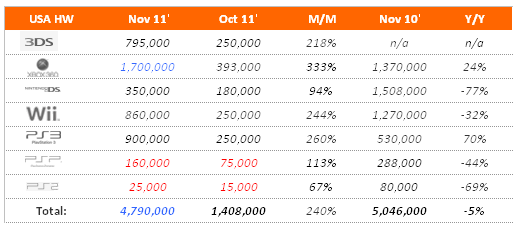
The major video games products manufactured by the Toy industry include PS2, Xbox, GC, Xbox360, Wii, PS3, DC, N64, PSI and Satum. The traditional toys manufacturing companies generate the largest percentage of the revenue generated by the Toy industry because it offers a variety of products (Bryson, & Rusten, 2011).
These products encompass building sets, action figures /accessories, dolls, games and puzzles, infants and preschools toys, outdoor and sports toys, plush, vehicles, youth electronics, arts and craft, pretend play, trading cards and other different toys. 75% of the toy industry revenue in THE U.S. is generated by the top 50 toy companies.
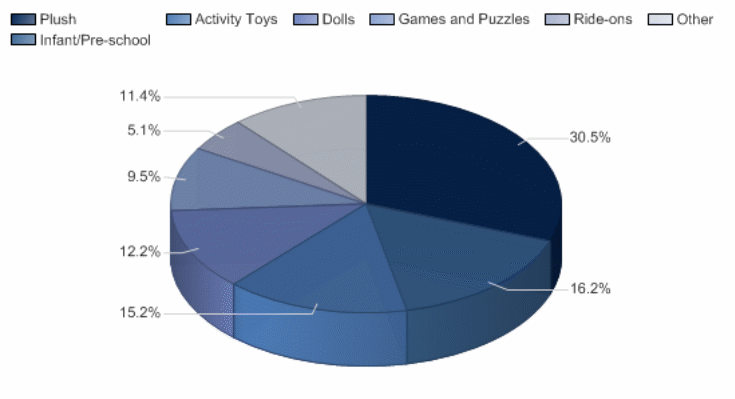
The estimated toy sales trends ascertain the fact that toy sales have been increasing and decreasing depending on the seasonality of the industry. In 2006, the toy industry generated $22.3 billion, which declined to $22.2 billion in 2007. In 2008, the revenue increased to $21.65.
This culminated into $21. 47 in 2009 that marked a decline from the revenue generated in 2008 (The NPD Group, 2011). In 2010 the revenue increased to $21.87, but later decline to $21.18 in 2011. The expected compound annual growth rate of revenues in the toy industry for the next five years encompasses 0.1 % from 2011 to 2016.
In this case, the revenue generated by 2016 is estimated as 22.095.8 (The NPD Group, 2011).From this sales trend, it can be ascertained that the sales trends keep increasing and decreasing depending on the seasonal nature of the toy industry.
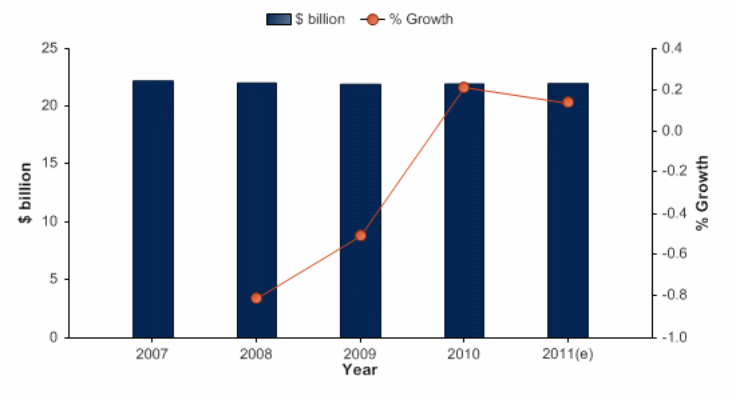
The current operational/ management trends in the toy industry encompass diversity in the types of toy products manufactured, reduction in the need for free-form play toys due to the reduction of time for role-play which calls for increased production of video games, acquisition of small toy companies by the large companies, radical changes in the number of diversified retail and independent chains, impacts of changes in technology that culminate into the innovation of newer toy products as well as changes in the business matters, sales, legal, ethical and trade imbalances in the toy industry (Auerbach, 2004).
The major marketing avenues utilized by companies in the Toy industry encompass television, magazines, Radio, newspapers, in-store displays, sweepstakes, use of brand name toys, trade show that used in forecasting industry sales, and acquisition of feedback by manufacturers from the retailers as well as the combined effort between the toy producing company and other companies that offer complementary products (Little $ King Company, LLC, 2010).
Other marketing strategies utilized by toy producing companies encompass company websites, post-launch reviews, print reviews, pre-launch reviews, special-in store promotions, as well as advertising in genre-specific toy magazines (Little $ King Company, LLC, 2010).
Essentially, large toy companies utilize licensing as a major marketing strategy, because it accords them with leverage in the competitive toy industry. As an addition to the above marketing strategies, many companies have ventured into the Internet-based retail services that enhance the purchase of toys by customers from the manufacturers rather that going through retailers (Little $ King Company, LLC, 2010).
The toy industry is identified as a seasonal industry. This is because major toy sales are done in the late third and fourth quarters of a year, due to the increase in demand for toys during the winter season. This seasonality definitely affects sales greatly.
Early-buy programs are offered by large toy companies to reduce the number of products over demand (Little $ King Company, LLC, 2010). During the period that spans over the quarters in which limited revenue is generated, such large companies capitalize on the promotion and sale of such non-holiday toys as sports and educational related toys.
To some extent the toy industry is sensitive to economic fluctuations. This is because as personal income increases, the retail sales for toys increase (Little $ King Company, LLC, 2010).
A 1.6% increase in personal income in 2009 culminated into a 3.8% increase in retail toy sales in the same year. Essentially, the toy retail sector is usually more resilient as compared to other companies during a recession, but it encompasses the first industry to recover after a recession.
Industry Developments
The competition that the Toy Industry has been undergoing from such electronic gadgets as iPods in the ever changing entertainment world has culminated to the development of the industry through various innovations. Green innovations span through the various green initiatives exhibited during the JAR Toy Fair.
Such green initiatives as the Erath Friendly Product Zone encompass the major contributions to the green initiatives (Bryson, & Rusten, 2011). A good example of this encompasses the Design4Planet program introduced by LEGO, aimed at establishing sustainable product designs that are environment friendly.
Various electronic items and video games have been introduced as innovations that can compete with the various electronic gadgets introduced through technological development in the modern world. This is a move that should stir traditional toy industries to think of how they can keep with the competition.
Such products of the toy Industry can compete effectively as compared to the traditional toys. Under product innovation, theme based toys and embedded technology has been introduced into the developing toy industry. Under embedded technology, such toys as programmable cars and robotic dog have been introduced.
Some companies have ventured into the production of toys based on children stories to increase their sales. Essentially, the toy industry has developed continually by embracing on-line sales of various toy products.
The International Council of Toy Industries (ICTI) has always been committed to the promotion of toy safety as one of the major government regulation governing the THE U.S. toy industry while working with standard bodies to improve the safety requirements when producing toys. (International Council of Toy Industries, 2010).
In this case, they ensure that toys are produced for particular children categories and they do not pose any risks or accidents to such particular categories.
New toys should also be fitted with safety devices that can withstand tear and wear as they enhance the safety of the users. Essentially, as part of the government regulations, the toys producing companies possess the social responsibility of ensuring that all employees engaged in the production of toys, are accorded with favorable working conditions (International Council of Toy Industries, 2011).
ICTI organizes annual trade shows in which qualifying companies from all over the world are allowed to exhibit new products. These exhibits are however subjected to various government regulations in terms of exhibit regulations as well as attendance qualifications (International Council of Toy Industries, 2011).
Traffic and non-tariff trade barriers exist in the international trade industry. Such are however regulated through various government regulations that ensure unfair trade practices are eliminated from the developing international toy industry.
In terms of the consumer market data, 28.2% of the Global market value can be accounted to THE U.S., while 27.8% can be accounted to Europe.
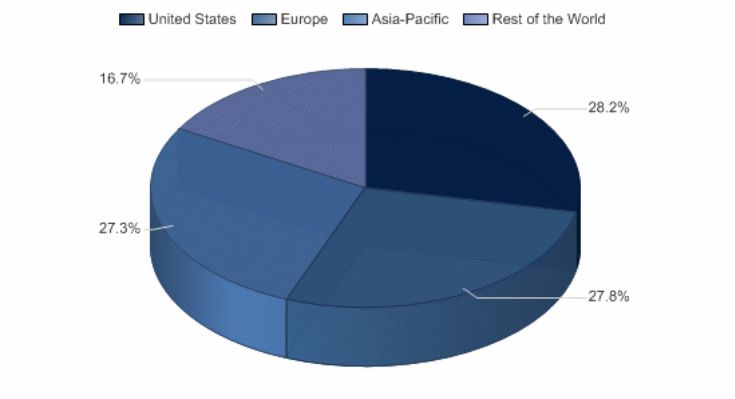
In terms of consumer market distribution, the leading distributers of toys in the consumer market encompass specialist stores, Hypermarkets, Supermarkets, discounters, department’s stores, general retails as well as other distributors (Bryson & Rusten, 2011).
30.7% of the distribution can be attributed to the Hypermarkets, Supermarkets and discounters. Specialist stores account for 52.8%, general retailers account for 6.8%, department stores account for 5.25 while other distributors account for 4.6% as shown by the pie chart below.
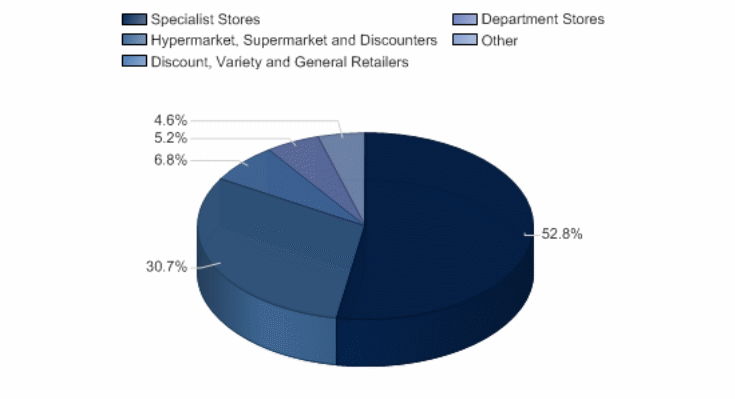
Competitor Information
The modern Toy Industry in THE U.S. is dominated by such leaders as Mattel, Hasbro and JAKKS Pacific. Mattel encompasses the largest toy producing company In America in terms of revenue. Essentially, it encompasses the largest toy manufacturer in the world.
In 2010, the company generated $6 billion in net sales and $ 700 million in net income. Mattel produces Barbie dolls, master of the universe, board games, Fisher Price, Hot Wheels, American Girl Dolls and Matchbox toys. Its headquarters are situated in El Segundo, California (Bryson & Rusten, 2011).
49% of its Gross sales is accounted for by the company’s international revenue that originates from Europe, Asia and Latin America (Bryson & Rusten, 2011). The company was established in 1945, but begun its first Barbie product line in 1959.
It gained its fame in the 1960s through its talking dolls production. In 2002, the company closed shop in Africa and transferred its business through outsourcing to China.
Hasbro encompasses the second leading toy company In THE U.S. that is engaged in the manufacture of card games, educations games, boards games and other family games. It recorded $4 billion in net sales and $ 400 million net income in 2010.
Its headquarters are situated in Pawtucket, Rhode Island, but the major percentage of its products is produced in East Asia (Bryson & Rusten, 2011). Its first toy was produced in 1940’s inform of nurse and doctor kits, the company’s first toy that gained popularity in the toy market encompasses Mr. Potato Head that was produced in 1952.
Their first action figure, G.I Joe was produced in 1964 and the company’s name was shorted from Hassenfeld Brothers to Hasbro industries in 1968. Currently it encompasses a parent company to various subsidiaries.
Apart from the manufacturing facilities owned and operated in Asia, the company operates two manufacturing facilities in East Longmeadow, Massachusetts and Waterford, Ireland.
JAKKS Pacific encompasses the third largest toy manufacturing company in THE U.S. whose revenue is generated from the production of toy cars, video games, dolls and action figures (Bryson & Rusten, 2011). In 2010, it recorded $ 750 million in net sales and $50 million net income.
It was established in 1995 in Malibu California and started to acquire small toy companies up to 2008. It has managed to acquire the third position in the toy market through licensing agreements, strategic acquisitions as well as product development.
Competition in the Toy Industry cannot only be limited to the large businesses in the industry; it also spans the competition from other toy producing companies in the world. THE U.S. imports most of its toys from China (Bryson & Rusten, 2011).
In this case, the American Toy producing companies encounter considerable competition from the Chinese Toy Producing companies. This competition is something to awaken the traditional toy companies, especially the THE U.S. based companies which are facing still competition in the current market.
In 2008, the U.S consumption of toys amounted to $24 billion. 85% of this consumption was met by the Chinese toy producing companies. This consumption reduced to $22 billion in 2010, but the percentage met by the Chinese toy companies did not reduce.
From the two exhibits below, it can be concluded that though China encompasses the major competitor of the United States toy industry, the Topy Producing companies in U.S still encounter surmountable competition from Toy manufacturing companies in Japan, Mexico, Taiwan, Indonesia, Denmark, Canada, Hong Kong, Thailand and Germany.
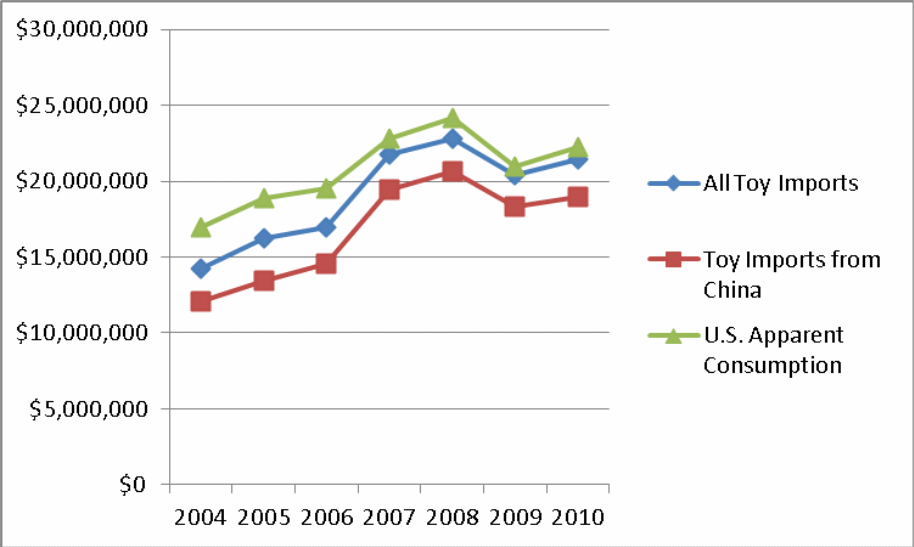
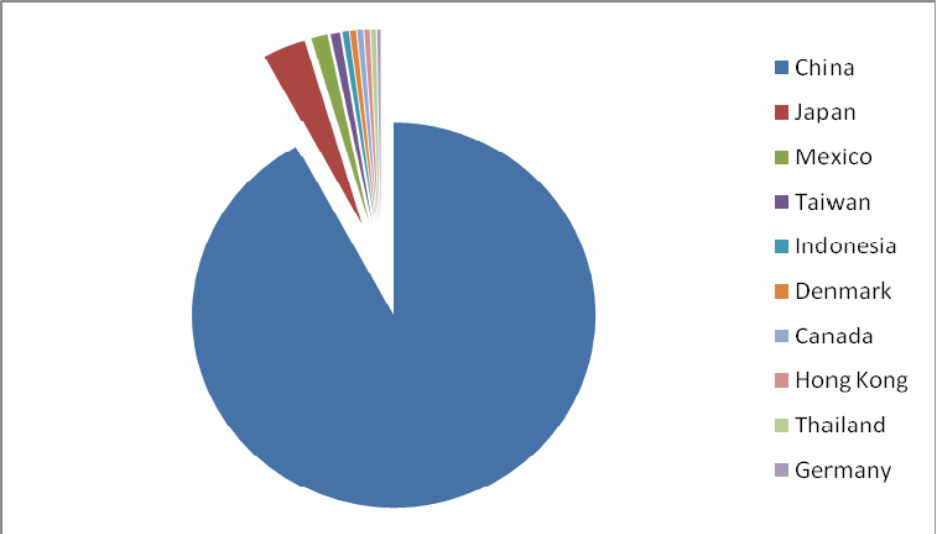
Summary of the Analysis
The comprehensive industry analysis of the THE U.S. toy industry has been divided into nature of the industry, industry development and competitor information. Under the nature of the industry, the estimate size of the industry encompasses $78 billion revenue generation by the international Toy industry of which $21.18 can be attributed to the U.S toy industry.
In terms of sales trends, sales have been on the decrease from 2007 to 2011 but an estimated 0.1% increase is expected to be attained by 2016. Such operational/management trends as the acquisition of small toy companies can be attributed to the nature of the toy industry.
Various marketing strategies that include Internet-based retail services can be attributed to the nature of the industry. The toy Industry in American encompasses a seasonal industry that is affected by various economic fluctuations. In terms of industry development, the industry has undergone various innovations and government regulations ion its development course.
Essentially, the consumer market data provided ascertains that U.S accounts the highest consumer market value in the international toy industry. Inherently, specialized stores encompass the highest toy distributors in the consumer market. Competitor information ascertains the major businesses in the U.S toy industries include Mattel, Hasbro and JAKKS Pacific.
Though Mattel is identified as the largest toy producer in U.S, it is also identified as the largest toy manufacturer in the world. Though these companies pose considerable competition to other toy [producing companies in U.S, toy producing companies from china, Japan, Mexico, Taiwan, Indonesia, Denmark, Canada, Hong Kong, Thailand and Germany also pose surmountable competition.
References
Auerbach, S. (2004). Toy industry: Past, present and future. The Big Game Hunter. Web.
Bryson, J., R. & Rusten, G. (2011). Design economies and the changing world economy: innovation, production and competitiveness. New York, NY: Taylor & Francis.
International Council of Toy Industries. (2011). Industry information. Web.
Little $ King Company, LLC. (2010). The transformational toy manufacturing industry. Web.
The NPD Group. (2011). THE U.S. toy industry retail sales generated $21.18 billion in 2011. Web.